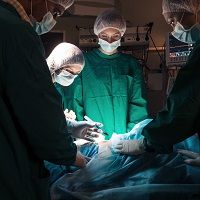Article
Evaluating Patients for Risk of Exocrine Pancreatic Insufficiency After Gastric Bypass Surgery
Author(s):
New research may help explain the connection between exocrine pancreatic insufficiency, gastric bypass surgery, and oxalate nephropathy in humans.

New research in pigs may help explain — and manage —the connection between exocrine pancreatic insufficiency, gastric bypass surgery, and oxalate nephropathy in humans.
Prior studies have consistently shown that patients who undergo Roux-en-Y gastric bypass (RYGB) surgery and those who develop exocrine pancreatic insufficiency are at greater risk of developing buildups of crystalized calcium oxalate that can cause acute renal failure.
Part of the connection is understandable. A primary aim of RYGB surgery is to induce the body to digest many of its own pancreatic enzymes before those enzymes come into contact with food, so the effects of the surgery naturally mimic the outcomes of natural pancreatic insufficiency in many ways.
However, according to the Swedish and Polish researchers who conducted the study, it is unclear exactly why people with diminished pancreatic function would be more likely to develop hyperoxaluria or any of the problems it can create.
“The etiology of post-RYGB hyperoxaluria is not completely understood, but is believed to arise from enteric malabsorption due to reduced small intestine surface area available for nutrient absorption as well as a shortened gastrointestinal transit time,” they wrote in the journal Postepy Nauk Medycznych.
“Moreover, limited contact of food with pancreatic enzymes reduces digestion and a malabsorptive state is established, leading to derangements in calcium and oxalate metabolism. Calcium metabolism is altered by its reduced absorption in the bypassed segments of the small intestine.”
The researchers hypothesized from this observation that they might be able to discover the underlying mechanism of the connection — and learn how real world patients with diminished pancreatic function can eat to minimize the risk of hyperoxaluria — by performing RYGB surgery on pigs, systematically changing the amount of calcium and potassium they consumed and noting changes to blood and urine samples.
<!--page-->
The study team acquired 11 piglets aged 5 to 7 weeks, performed RYGB surgery on 7 of them and used the other 4 as a control group. All of the pigs started with a normal diet, then switched to diets with extra potassium oxalate before returning to a normal pig diet. Some of the RYGB pigs then went on to eat something that approximated a normal human diet and, finally, a low-calcium human diet.
When the pigs began on the regular pig diet, the average amount of oxalate in RYGB pig urine was nearly twice that of control pig urine. However, by the 51st day of the study, oxalate levels had basically equalized.
The amount of oxalate in the urine of RYGB pigs and control pigs diverged again — it was far higher in the study group — when researchers added the potassium oxalate to the food that both groups ate, and a large gap remained even after they returned to the regular diet.
The diet variations failed to induce hyperoxaluria in any of the pigs over the course of the 12-week study, but the speed and consistency with which changes in food produced changes the oxalate content of pig urine, along with content of related compounds in both blood and urine, suggests that the model the researchers created may provide answers if given enough time to do actual damage.
“Dietary oxalate governs the development of enteric hyperoxaluria in bariatric pigs, which are more sensitive to it than intact control pigs,” they wrote. “The pig model described in the present study could be a sensitive tool used to highlight the mechanisms of enteric hyperoxaluria following RYGB in humans. The interaction between exocrine pancreatic insufficiency and bariatric surgery should be also more profoundly explored.”




